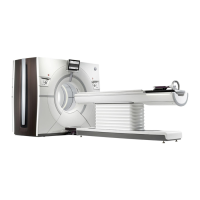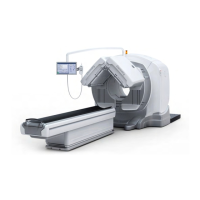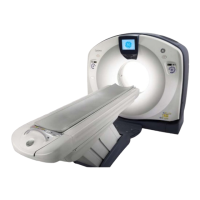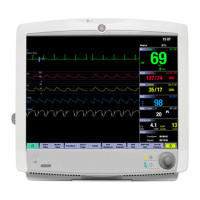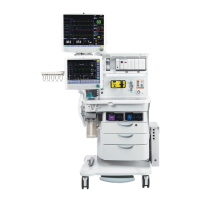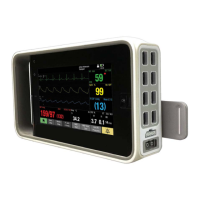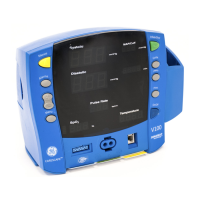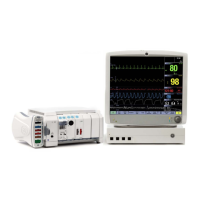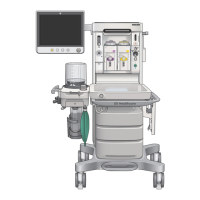Do you have a question about the GE CT-9800 and is the answer not in the manual?
Specifies requirements for electrical installations and personnel qualifications for servicing.
Procedures for handling and reporting shipping damage to equipment.
Instructions for reporting documentation errors or defects.
Details on identifying system components and options, including H.H.S. certification.
Information on H.H.S. certification, regulatory standards, and required documentation.
Importance of temperature checks and cooling requirements for system components.
Procedures for monitoring line voltage, disturbances, and ensuring equipment specifications are met.
Steps to verify system grounding integrity and electrical connections.
Procedures for verifying power application, phase sequence, and load distribution.
Guidance on X-ray line transformer settings and jumper configurations.
Procedures for testing power interlocks and computer thermostat functionality.
Procedures for testing the SEO system emergency OFF and table/console emergency OFF.
Referrals to procedures for alpha-numeric adjustments in the Display Subsystem Manual.
Procedures for adjusting the 6026 Mag Tape Drive, including command string usage.
Procedures for disk system adjustments, referencing Data General documentation.
Specifies requirements for X-Ray alignment and critical components.
Details physical positioning of tube, detector, and collimator for X-ray alignment.
Checks and adjusts X-ray fan beam plane of rotation for perpendicularity.
Checks and adjusts Xenon detector window position for beam interception.
Verifies tube output and normal channel output for integrity.
Aligns tube focal spot with detector center for accurate spatial sampling.
Aligns body filter center with ISO alignment for Xenon detectors.
Measures alignment changes and hysteresis in channel numbers during rotation.
Checks channel 1 intensity for detector wedge verification.
Specifies records to be saved for H.H.S. purposes after X-ray alignment.
Steps to follow after X-ray alignment, including Q cal file creation.
Outlines requirements for X-ray alignment on HiLight detector systems.
Details positioning of tube, detector, and collimator for HiLight X-ray alignment.
Procedure for adjusting detector radial position after installation or removal.
Aligns tube focal spot with detector center for HiLight systems.
Aligns body filter center with ISO alignment for HiLight detectors.
Measures alignment changes and hysteresis in channel numbers during rotation.
Overview of alignment adjustments and laser safety precautions.
Step-by-step sequence for performing comprehensive alignment procedures.
Lists necessary special tools and preliminary steps for alignment.
Instructions for properly installing and centering the laser alignment tool.
Procedures for aligning internal axial laser lights for beam centering.
Procedures for aligning sagittal laser light and adjusting beam positioning.
Procedures for aligning coronal laser lights and adjusting beam positioning.
Procedures for aligning external axial laser lights and adjusting beam positioning.
Verifies table perpendicularity to scan plane using laser alignment tool.
Centers table in scan plane after perpendicularity is confirmed.
Explanation of R-level commands and available system options.
Details on accessing and using CTDS diagnostic programs from tape.
Information on the STATE$REP.TM file for tracking disk drive status and ECC errors.
Explains RECON SHUTDOWN messages and troubleshooting steps for failed reconstructions.
Information on software changes and known issues from release notices.
Steps to enter the system error log for review and analysis.
Guidance on analyzing error reports, identifying sequences, and determining causes.
Explains error message formats and how to decode them using system software.
Procedures for partitioning error logs by setting breakpoints for better management.
Details panic codes posted to the console upon major system faults and suggested actions.
Lists system errors posted as Fortran or RDOS codes and their parameters.
Procedure for creating a Crash Tape for system hang analysis.
Steps to isolate problems within the computer, disk drive, or mag tape drive.
Primary references and checkout procedures for Zebra and Argus disk drives.
Technical manual references and troubleshooting procedures for the Mag Tape Drive.
Initial tests to determine if S140 and ST-CT processors can communicate.
Common errors related to UPAP and their resolution steps.
Troubleshooting common errors encountered at the "M" level of system operation.
Identifies kernel abort codes and provides solutions for AP hardware failures.
Explains image aliasing and ISO alignment errors, with troubleshooting suggestions.
Troubleshooting common issues encountered with mag tape drives.
Troubleshooting image artifacts like streaks when the system is unresponsive.
Introduction to AutoTest and AutoSummary for identifying center artifacts.
How AutoSummary filters and organizes AutoTest log data for analysis.
Guidelines for understanding AutoSummary results and determining appropriate actions.
Common causes of image quality issues and artifacts to resolve before AutoSummary.
Procedure for obtaining detector identification numbers from the rating plate.
Specifies requirements for electrical installations and personnel qualifications for servicing.
Procedures for handling and reporting shipping damage to equipment.
Instructions for reporting documentation errors or defects.
Details on identifying system components and options, including H.H.S. certification.
Information on H.H.S. certification, regulatory standards, and required documentation.
Importance of temperature checks and cooling requirements for system components.
Procedures for monitoring line voltage, disturbances, and ensuring equipment specifications are met.
Steps to verify system grounding integrity and electrical connections.
Procedures for verifying power application, phase sequence, and load distribution.
Guidance on X-ray line transformer settings and jumper configurations.
Procedures for testing power interlocks and computer thermostat functionality.
Procedures for testing the SEO system emergency OFF and table/console emergency OFF.
Referrals to procedures for alpha-numeric adjustments in the Display Subsystem Manual.
Procedures for adjusting the 6026 Mag Tape Drive, including command string usage.
Procedures for disk system adjustments, referencing Data General documentation.
Specifies requirements for X-Ray alignment and critical components.
Details physical positioning of tube, detector, and collimator for X-ray alignment.
Checks and adjusts X-ray fan beam plane of rotation for perpendicularity.
Checks and adjusts Xenon detector window position for beam interception.
Verifies tube output and normal channel output for integrity.
Aligns tube focal spot with detector center for accurate spatial sampling.
Aligns body filter center with ISO alignment for Xenon detectors.
Measures alignment changes and hysteresis in channel numbers during rotation.
Checks channel 1 intensity for detector wedge verification.
Specifies records to be saved for H.H.S. purposes after X-ray alignment.
Steps to follow after X-ray alignment, including Q cal file creation.
Outlines requirements for X-ray alignment on HiLight detector systems.
Details positioning of tube, detector, and collimator for HiLight X-ray alignment.
Procedure for adjusting detector radial position after installation or removal.
Aligns tube focal spot with detector center for HiLight systems.
Aligns body filter center with ISO alignment for HiLight detectors.
Measures alignment changes and hysteresis in channel numbers during rotation.
Overview of alignment adjustments and laser safety precautions.
Step-by-step sequence for performing comprehensive alignment procedures.
Lists necessary special tools and preliminary steps for alignment.
Instructions for properly installing and centering the laser alignment tool.
Procedures for aligning internal axial laser lights for beam centering.
Procedures for aligning sagittal laser light and adjusting beam positioning.
Procedures for aligning coronal laser lights and adjusting beam positioning.
Procedures for aligning external axial laser lights and adjusting beam positioning.
Verifies table perpendicularity to scan plane using laser alignment tool.
Centers table in scan plane after perpendicularity is confirmed.
Explanation of R-level commands and available system options.
Details on accessing and using CTDS diagnostic programs from tape.
Information on the STATE$REP.TM file for tracking disk drive status and ECC errors.
Explains RECON SHUTDOWN messages and troubleshooting steps for failed reconstructions.
Information on software changes and known issues from release notices.
Steps to enter the system error log for review and analysis.
Guidance on analyzing error reports, identifying sequences, and determining causes.
Explains error message formats and how to decode them using system software.
Procedures for partitioning error logs by setting breakpoints for better management.
Details panic codes posted to the console upon major system faults and suggested actions.
Lists system errors posted as Fortran or RDOS codes and their parameters.
Procedure for creating a Crash Tape for system hang analysis.
Steps to isolate problems within the computer, disk drive, or mag tape drive.
Primary references and checkout procedures for Zebra and Argus disk drives.
Technical manual references and troubleshooting procedures for the Mag Tape Drive.
Initial tests to determine if S140 and ST-CT processors can communicate.
Common errors related to UPAP and their resolution steps.
Troubleshooting common errors encountered at the "M" level of system operation.
Identifies kernel abort codes and provides solutions for AP hardware failures.
Explains image aliasing and ISO alignment errors, with troubleshooting suggestions.
Troubleshooting common issues encountered with mag tape drives.
Troubleshooting image artifacts like streaks when the system is unresponsive.
Introduction to AutoTest and AutoSummary for identifying center artifacts.
How AutoSummary filters and organizes AutoTest log data for analysis.
Guidelines for understanding AutoSummary results and determining appropriate actions.
Common causes of image quality issues and artifacts to resolve before AutoSummary.
Procedure for obtaining detector identification numbers from the rating plate.
| Brand | GE |
|---|---|
| Model | CT-9800 |
| Category | Medical Equipment |
| Language | English |
